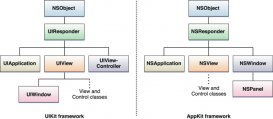句柄
要操纵一个数据库你就得有一个这个数据库的句柄(又碰到这个难以理解的词了,不过确实还没得一个更好的词来替代它)。其实你跟本不需要去在乎这个词叫什么,你只要搞清楚他是一个什么玩意儿。就如同鞋子为什么叫鞋子,仔细想想确实也难以理解,不过 清楚他的功能就OK了,不是吗?
句柄在很多地方我们见到过,最常见的就是文件的句柄,我们要操纵一个文件,我们就要取得一个文件的句柄。句柄是个什么东东呢?其实很简单,句柄是一个东东的描述,他被定义为一个结构体,这个结构体可能会包含要描述的东东的具体信息,比如位置、大小、类型等等。我们有了这个描述信息我们就能去找到这个东东,然后操纵它。
一句话:句柄是物体的描述结构体。
我们来看看sqlite的句柄是怎么定义的(不要被吓到了,代码直接跳过就好):
|
1
2
3
4
5
6
7
8
9
10
11
12
13
14
15
16
17
18
19
20
21
22
23
24
25
26
27
28
29
30
31
32
33
34
35
36
37
38
39
40
41
42
43
44
45
46
47
48
49
50
51
52
53
54
55
56
57
58
59
60
61
62
63
64
65
66
67
68
69
70
71
72
73
74
75
76
77
78
79
80
81
82
83
84
85
86
87
88
89
90
91
92
93
94
95
96
97
98
99
100
101
102
103
104
105
106
107
108
109
110
|
struct sqlite3 { sqlite3_vfs *pVfs; /* OS Interface */ int nDb; /* Number of backends currently in use */ Db *aDb; /* All backends */ int flags; /* Miscellaneous flags. See below */ unsigned int openFlags; /* Flags passed to sqlite3_vfs.xOpen() */ int errCode; /* Most recent error code (SQLITE_*) */ int errMask; /* & result codes with this before returning */ u8 autoCommit; /* The auto-commit flag. */ u8 temp_store; /* 1: file 2: memory 0: default */ u8 mallocFailed; /* True if we have seen a malloc failure */ u8 dfltLockMode; /* Default locking-mode for attached dbs */ signed char nextAutovac; /* Autovac setting after VACUUM if >=0 */ u8 suppressErr; /* Do not issue error messages if true */ u8 vtabOnConflict; /* Value to return for s3_vtab_on_conflict() */ int nextPagesize; /* Pagesize after VACUUM if >0 */ int nTable; /* Number of tables in the database */ CollSeq *pDfltColl; /* The default collating sequence (BINARY) */ i64 lastRowid; /* ROWID of most recent insert (see above) */ u32 magic; /* Magic number for detect library misuse */ int nChange; /* Value returned by sqlite3_changes() */ int nTotalChange; /* Value returned by sqlite3_total_changes() */ sqlite3_mutex *mutex; /* Connection mutex */ int aLimit[SQLITE_N_LIMIT]; /* Limits */ struct sqlite3InitInfo { /* Information used during initialization */ int iDb; /* When back is being initialized */ int newTnum; /* Rootpage of table being initialized */ u8 busy; /* TRUE if currently initializing */ u8 orphanTrigger; /* Last statement is orphaned TEMP trigger */ } init; int nExtension; /* Number of loaded extensions */ void **aExtension; /* Array of shared library handles */ struct Vdbe *pVdbe; /* List of active virtual machines */ int activeVdbeCnt; /* Number of VDBEs currently executing */ int writeVdbeCnt; /* Number of active VDBEs that are writing */ int vdbeExecCnt; /* Number of nested calls to VdbeExec() */ void (*xTrace)(void*,const char*); /* Trace function */ void *pTraceArg; /* Argument to the trace function */ void (*xProfile)(void*,const char*,u64); /* Profiling function */ void *pProfileArg; /* Argument to profile function */ void *pCommitArg; /* Argument to xCommitCallback() */ int (*xCommitCallback)(void*); /* Invoked at every commit. */ void *pRollbackArg; /* Argument to xRollbackCallback() */ void (*xRollbackCallback)(void*); /* Invoked at every commit. */ void *pUpdateArg; void (*xUpdateCallback)(void*,int, const char*,const char*,sqlite_int64); #ifndef SQLITE_OMIT_WAL int (*xWalCallback)(void *, sqlite3 *, const char *, int); void *pWalArg; #endif void(*xCollNeeded)(void*,sqlite3*,int eTextRep,const char*); void(*xCollNeeded16)(void*,sqlite3*,int eTextRep,const void*); void *pCollNeededArg; sqlite3_value *pErr; /* Most recent error message */ char *zErrMsg; /* Most recent error message (UTF-8 encoded) */ char *zErrMsg16; /* Most recent error message (UTF-16 encoded) */ union { volatile int isInterrupted; /* True if sqlite3_interrupt has been called */ double notUsed1; /* Spacer */ } u1; Lookaside lookaside; /* Lookaside malloc configuration */ #ifndef SQLITE_OMIT_AUTHORIZATION int (*xAuth)(void*,int,const char*,const char*,const char*,const char*); /* Access authorization function */ void *pAuthArg; /* 1st argument to the access auth function */ #endif #ifndef SQLITE_OMIT_PROGRESS_CALLBACK int (*xProgress)(void *); /* The progress callback */ void *pProgressArg; /* Argument to the progress callback */ int nProgressOps; /* Number of opcodes for progress callback */ #endif #ifndef SQLITE_OMIT_VIRTUALTABLE Hash aModule; /* populated by sqlite3_create_module() */ VtabCtx *pVtabCtx; /* Context for active vtab connect/create */ VTable **aVTrans; /* Virtual tables with open transactions */ int nVTrans; /* Allocated size of aVTrans */ VTable *pDisconnect; /* Disconnect these in next sqlite3_prepare() */ #endif FuncDefHash aFunc; /* Hash table of connection functions */ Hash aCollSeq; /* All collating sequences */ BusyHandler busyHandler; /* Busy callback */ int busyTimeout; /* Busy handler timeout, in msec */ Db aDbStatic[2]; /* Static space for the 2 default backends */ Savepoint *pSavepoint; /* List of active savepoints */ int nSavepoint; /* Number of non-transaction savepoints */ int nStatement; /* Number of nested statement-transactions */ u8 isTransactionSavepoint; /* True if the outermost savepoint is a TS */ i64 nDeferredCons; /* Net deferred constraints this transaction. */ int *pnBytesFreed; /* If not NULL, increment this in DbFree() */ #ifdef SQLITE_ENABLE_UNLOCK_NOTIFY /* The following variables are all protected by the STATIC_MASTER ** mutex, not by sqlite3.mutex. They are used by code in notify.c. ** ** When X.pUnlockConnection==Y, that means that X is waiting for Y to ** unlock so that it can proceed. ** ** When X.pBlockingConnection==Y, that means that something that X tried ** tried to do recently failed with an SQLITE_LOCKED error due to locks ** held by Y. */ sqlite3 *pBlockingConnection; /* Connection that caused SQLITE_LOCKED */ sqlite3 *pUnlockConnection; /* Connection to watch for unlock */ void *pUnlockArg; /* Argument to xUnlockNotify */ void (*xUnlockNotify)(void **, int); /* Unlock notify callback */ sqlite3 *pNextBlocked; /* Next in list of all blocked connections */ #endif }; typedef struct sqlite3 sqlite3;// |
是不是被吓到了,没关系,这段代码本来就是我贴出来吓唬你的,我也没认真研究过这个代码,也不想去研究,除非哪天有人出高价请我去研究,我现在只知道怎么用就好了。
这个 sqlite3 结构体就是被用来描述我们磁盘里的数据库文件的,有了这个描述符我们就可以对这个数据库进行各种操作了,操作的具体内情我们不必要了解,我们只需要知道怎么去调用API就好了,当然有时候还是要了解一点点内情的,这个以后碰到再讲。
我用这么长的话加一大段吓人的代码只有一个目的:不要对句柄有恐惧感。
好了,开始我们的正题,sqlite 里面你要操纵数据库我们先得创建一个句柄,然后后面所有对数据库得操作都会用到这个句柄。
|
1
|
sqlite3* pdb; |
就 这么简单,这样一个ssqlite的句柄我们就创建完成了,我们以后针对数据库的操作都离不开它了。
打开、关闭、创建 数据库
我创建了一个句柄,但是我怎么知道这个句柄指向的是磁盘上哪个数据库文件呢?我们只是创建了一个指针,指向一个 sqlite3 类型的结构体。里面的数据都是空的或者默认的。我们接下来要做的就是去为这个结构体申请内存并填充这个结构体。是不是感觉又被吓到了?这个结构体这么庞大,我们自己去填充还不的猴年马月啊。一切都不用害怕,并不需要我们显式的去填充它,我们只需要告诉它一些最基本的信息,然后调用API让API去帮我们填充。
目前我们只需要告诉这个结构体一个信息,就是数据库文件的路径。然后调用 sqlite3_open 函数就OK了。
|
1
2
3
4
|
SQLITE_API int sqlite3_open(//SQLITE_API 是个宏,用来标注API的不用理它 const char *zFilename, sqlite3 **ppDb ); |
第一个参数是路径,const char * 型,第二个参数是数据库句柄的指针,注意是一个二级指针,我们声明的一级指针,所以我们还要加一个取地址符&,请看我下面的实例:
|
1
|
int ret = sqlite3_open( getFilePath(), &pdb);// |
不要奇怪,其实打开数据库就是获得数据库的一些信息,然后方便我们操纵它,不是吗?通过这个函数 我们把 数据库与 句柄 pdb 绑定在一起了,我们以就通过 这个 pdb 来操纵数据库了。在这个函数中第一个参数是数据库文件的路径(包括文件名),我一般会把路径写成一个函数,这样遵循编码原则(这里用到的原则是一个函数尽量只做一件事情),建议你也这样,好处你自己可以慢慢体会到。我获取路径的函数如下你可以参考一下:
|
1
2
3
4
5
|
const char* getFilePath(){ return [[NSString stringWithFormat:@"%@/Documents/db",NSHomeDirectory() ] UTF8String]; //不好意思这里用到了与IOS相关的一点东西,不过这个也没办法,除非我写成绝对路径,但是那样是行不通的 // 不过也没关系,你移植到别处肯定也是要改路径的咯,所以移植的时候改一下就好了 } |
还有一点就是返回值,返回值我们用来判断是否执行成功。sqlite 中帮我们定义了一系列的宏,用来作为返回值:
|
1
2
3
4
5
6
7
8
9
10
11
12
13
14
15
16
17
18
19
20
21
22
23
24
25
26
27
28
29
30
31
|
#define SQLITE_OK 0 /* Successful result */ /* beginning-of-error-codes */ #define SQLITE_ERROR 1 /* SQL error or missing database */ #define SQLITE_INTERNAL 2 /* Internal logic error in SQLite */ #define SQLITE_PERM 3 /* Access permission denied */ #define SQLITE_ABORT 4 /* Callback routine requested an abort */ #define SQLITE_BUSY 5 /* The database file is locked */ #define SQLITE_LOCKED 6 /* A table in the database is locked */ #define SQLITE_NOMEM 7 /* A malloc() failed */ #define SQLITE_READONLY 8 /* Attempt to write a readonly database */ #define SQLITE_INTERRUPT 9 /* Operation terminated by sqlite3_interrupt()*/ #define SQLITE_IOERR 10 /* Some kind of disk I/O error occurred */ #define SQLITE_CORRUPT 11 /* The database disk image is malformed */ #define SQLITE_NOTFOUND 12 /* Unknown opcode in sqlite3_file_control() */ #define SQLITE_FULL 13 /* Insertion failed because database is full */ #define SQLITE_CANTOPEN 14 /* Unable to open the database file */ #define SQLITE_PROTOCOL 15 /* Database lock protocol error */ #define SQLITE_EMPTY 16 /* Database is empty */ #define SQLITE_SCHEMA 17 /* The database schema changed */ #define SQLITE_TOOBIG 18 /* String or BLOB exceeds size limit */ #define SQLITE_CONSTRAINT 19 /* Abort due to constraint violation */ #define SQLITE_MISMATCH 20 /* Data type mismatch */ #define SQLITE_MISUSE 21 /* Library used incorrectly */ #define SQLITE_NOLFS 22 /* Uses OS features not supported on host */ #define SQLITE_AUTH 23 /* Authorization denied */ #define SQLITE_FORMAT 24 /* Auxiliary database format error */ #define SQLITE_RANGE 25 /* 2nd parameter to sqlite3_bind out of range */ #define SQLITE_NOTADB 26 /* File opened that is not a database file */ #define SQLITE_ROW 100 /* sqlite3_step() has another row ready */ #define SQLITE_DONE 101 /* sqlite3_step() has finished executing */ /* end-of-error-codes */ |
有了这些我们就可以更加方便地调试我们的代码了。
好了,进入正题,上面这个函数就是在数据库存在的情况下打开数据库,不存在的情况下创建数据库,数据库的名字可以随便乱取,只要是ASCII字符就好了,因为sqlite数据库本来就是一个ASCII文件(所以它的安全性还是不大行的,不过作为本地数据库没啥问题)。
数据库打开后我们就可以进行一系列的增删查改的操作了,操作完毕我们就要关闭数据库,不是么?否则怎么释放资源呢?
关闭也很简单:
|
1
|
SQLITE_API int sqlite3_close(sqlite3 *db); |
这个就不用解释了吧,直接看我的实例:
|
1
|
sqlite3_close(pdb);// 这里就可以不去考虑返回值了 |
















